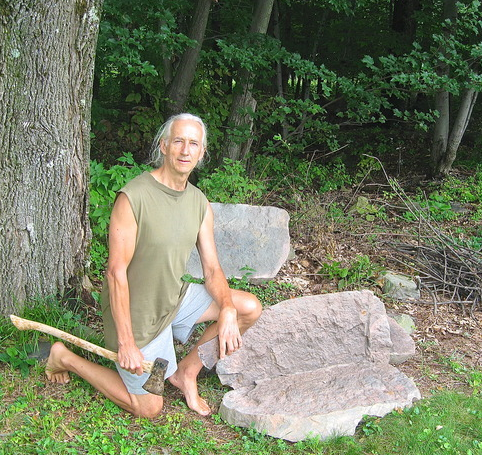Minimalism is much more than good-form running in lightweight, flat-sole, flexible footwear. Minimalism is found in music (Philip Glass, John Cage), literature (Raymond Carver), and architecture (Ludwig Mies van der Rohe). Minimalism’s unifying feature or motto is “less is more.” To those looking to lead a minimalist lifestyle, it means knowing how to de-clutter and personally downsize while avoiding the modern siren’s call of runaway consumerism. Minimalism asks one to simplify, unplug, and prioritize what’s absolutely essential in one’s life. Excess is banished because it gets in the way.
 Over a 150 years ago, Henry David Thoreau, who is America’s secular saint of minimalism, went and lived in the woods outside Concord, Mass, where he built a small, one-room cabin in a second-growth forest by Walden Pond. In addition to being a historian and naturalist, Thoreau was a tax-resisting, civil disobedient seeker of truth and authenticity. He wanted to experience life in its most simple, stripped-down essentials. That back-to-basics inclination was his impetus to move away from the hustle and bustle of society–Walden was located just 1.5 miles from Thoreau’s family home– and live off the land.
Over a 150 years ago, Henry David Thoreau, who is America’s secular saint of minimalism, went and lived in the woods outside Concord, Mass, where he built a small, one-room cabin in a second-growth forest by Walden Pond. In addition to being a historian and naturalist, Thoreau was a tax-resisting, civil disobedient seeker of truth and authenticity. He wanted to experience life in its most simple, stripped-down essentials. That back-to-basics inclination was his impetus to move away from the hustle and bustle of society–Walden was located just 1.5 miles from Thoreau’s family home– and live off the land.
His DIY experiment in self-sufficiency and simplicity lasted two years, two months, and two days. “I went to the woods because I wanted to live deliberately,” he writes in his memoir, “Walden,” which condensed the time frame to a full calendar year. “Most of the luxuries and many of the so-called comforts of life are not…indispensable.”
When Thoreau lived off the grid, the grid in the mid-1800s was without electricity, computers, phones, or cars. Future generations of Americans have been inspired by his example and writings that often seemed as much spiritual as practical in their call to simplify life. Many have sought to live more authentically and naturally, such as those who flocked to communes that flourished in the late 60 and early 70s, to today’s growing paleo and locavore movements.
Going off the grid has tremendous appeal for those interested in a contemporary psyche-cleansing, but there’s also an added bonus going pre-industrial: the accompanying health and fitness benefits. With that said, please enjoy the following essay by Dr. Phil Maffetone, who “went to the woods” in upstate New York for the summer with his companion, Dr. Coralee Thompson. –Bill Katovsky
***
My Summer in Gilboa: Getting in Shape the Natural Way
by Dr. Phil Maffetone
 I spent my summer with Coralee in the small town of Gilboa, New York, which is tucked away in the hidden folds of the northern Catskill Mountains. Gilboa was established in 1760, and it now claims a population of just over 1,000 people. There are just a few small buildings in the town’s “center,” and no post office. It’s a remote place to live.
I spent my summer with Coralee in the small town of Gilboa, New York, which is tucked away in the hidden folds of the northern Catskill Mountains. Gilboa was established in 1760, and it now claims a population of just over 1,000 people. There are just a few small buildings in the town’s “center,” and no post office. It’s a remote place to live.
Gilboa has deep roots of connection with the past. The town name comes from Mount Gilboa, a biblical site in ancient Israel, where King Saul’s sons were slain by the Philistines, and Saul took his own life.
Gilboa, New York, also marks the location of the fossilized remains of the oldest known trees on earth. In 2007, fern-like trees called Wattieza were found here by a team of researchers.
Some 380 million years ago, the first forests were forming on our planet. Previous vegetation grew scattered here and there, but during this period, more dense areas of growth began turning swamps and plains into woodlands. Recently, researchers discovered what they believed to be one of the very first forests—the now fossilized floor existed during what is called the Devonian period of earth’s evolution. Signs of previously undiscovered large plants were found too, with one appearing to look much like a palm tree. Scientists said the location was once an ancient shoreline—a flat coastal oasis with a river running through.
I had been making regular pilgrimages to the Catskills for some time. When I was in private practice, my clinic was downstate and I always enjoyed the peace of escaping to these mountainous areas. My grownup kids and grandkids also live within a relatively short driving distance, making Gilboa a great retreat.
Gilboa’s isolation had great appeal for folks like myself and Coralee. We both like to live off the grid, at least as much as possible. Spending several months in Gilboa required using much of what the local land offered, including old tools and farming materials left behind by previous owners. We wanted to turn a homestead from the late 1700’s into a productive, efficient, healthy environment, all while hiking, mountain biking, and running. Furthermore, this was a good stopover place between two busy Music & Wellness Tour trips.
 Like with our small farm in Oracle, Arizona, the house is also located at the end of a dead end road. The farmhouse was built in 1790, with the original hand-cut hardwood frame and laid-stone foundation intact. Used for storage in the days before refrigeration and chemical additives, the dirt-floor basement temperatures remain quite cool even in summer, keeping the house temperate too. The cellar would now be used for cheese curing, made with fresh raw milk from a local 200-year old Jersey farm, and wine production.
Like with our small farm in Oracle, Arizona, the house is also located at the end of a dead end road. The farmhouse was built in 1790, with the original hand-cut hardwood frame and laid-stone foundation intact. Used for storage in the days before refrigeration and chemical additives, the dirt-floor basement temperatures remain quite cool even in summer, keeping the house temperate too. The cellar would now be used for cheese curing, made with fresh raw milk from a local 200-year old Jersey farm, and wine production.
The discovery of an old dug well in an area of what was probably an older main house long gone assured plenty of water, although two more modern wells on the property were safer sources.
An old barn was converted to a vegetable garden by removing the roof and fencing it in to keep deer, bear and other animals out. The soil was great but contained many large rocks. These were dug up and used to build walls, but splitting them into thin slices uncovered interesting fossils, not to mention their value in making pathways in muddy areas and steps.
An early trimming of an old apple tree brought edible fruit by late August. Still a bit bitter, like a Granny Smith, but great for smoothies. No doubt a Johnny Appleseed influence, the tree originally was probably used to make applejack—a fermented wine frozen to remove the pure liquid alcohol.
A newer tree grew nicer fruit, assuring a fresh supply. But a 100-plus year old apple tree had no life left, and its large trunk was turned into a beautiful useful bench for watching sunsets.
But all along, nature was growing and providing great food. In the surrounding woods, many varieties of wild berry plants grew everywhere. We picked a seemingly endless supply of black berries, red raspberries and blueberries. They yielded a lot of fresh food throughout the summer. A bit of forward thinking has assured us a better harvest next season. This included transplanting blueberries to a separate garden bed, and thinning the large blackberry patches. Other wild edibles included one of the most nutritious of plant foods, dandelions—perfect for daily smoothies and salads.
It was not long before the new garden produced food. These included squash, beans, tomatoes, and parsley. Most plentiful were large orange squash flowers, which were stuffed daily with other vegetables and homemade ricotta made from our fresh milk.
Chopping and splitting wood is a favorite natural workout. It beats going to the gym. Larger logs were used to make the garden beds, with smaller pieces split to fuel morning or evening living room fires. The moderate temperatures brought cool mornings, and on cloudy days a welcomed fire was added comfort. It also made a marvelous atmosphere for live acoustic music with new friends, and working on new songs.
A nearby small family farm provided inexpensive and delicious grass-fed beef. Other local sources of food included eggs, honey, and greens, which were surprisingly plentiful. But growing crops at home was the primary goal at this newly resurrected locale.
As the last of summer arrived, beech and acorn nuts started to drop from their large trees. We eyed both nuts for fall harvest. Both are high in healthy monounsaturated fats, and may make another treat offered by the current Gilboa forest.
Our first full summer in Gilboa was joyful, creative, and productive. It was also an ideal way for personal fitness building. This meant both aerobic and anaerobic conditioning with a daily, full-body natural workout of moving large rocks, chopping wood, picking berries, preparing the soil, and so on.
Living here for several months felt like a voyage back in time to that of a frontier or pre-modern experience, of finding fertile land, and then taking advantage of nature’s generous offerings. It was a summer well spent and more than ample nourishment for body and soul.
This essay originally appeared on Dr. Phil Maffetone’s website. For more “Off the Grid” essays, go here: http://www.philmaffetone.com/off-the-grid
